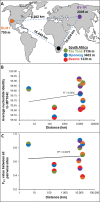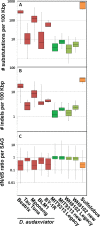Evolutionary stasis of a deep subsurface microbial lineage
- PMID: 33824425
- PMCID: PMC8443664
- DOI: 10.1038/s41396-021-00965-3
Evolutionary stasis of a deep subsurface microbial lineage
Abstract
Sulfate-reducing bacteria Candidatus Desulforudis audaxviator (CDA) were originally discovered in deep fracture fluids accessed via South African gold mines and have since been found in geographically widespread deep subsurface locations. In order to constrain models for subsurface microbial evolution, we compared CDA genomes from Africa, North America and Eurasia using single cell genomics. Unexpectedly, 126 partial single amplified genomes from the three continents, a complete genome from of an isolate from Eurasia, and metagenome-assembled genomes from Africa and Eurasia shared >99.2% average nucleotide identity, low frequency of SNP's, and near-perfectly conserved prophages and CRISPRs. Our analyses reject sample cross-contamination, recent natural dispersal, and unusually strong purifying selection as likely explanations for these unexpected results. We therefore conclude that the analyzed CDA populations underwent only minimal evolution since their physical separation, potentially as far back as the breakup of Pangea between 165 and 55 Ma ago. High-fidelity DNA replication and repair mechanisms are the most plausible explanation for the highly conserved genome of CDA. CDA presents a stark contrast to the current model organisms in microbial evolutionary studies, which often develop adaptive traits over far shorter periods of time.
© 2021. The Author(s).
Conflict of interest statement
The authors declare no competing interests.
Figures





References
Publication types
MeSH terms
LinkOut - more resources
Full Text Sources
Other Literature Sources

